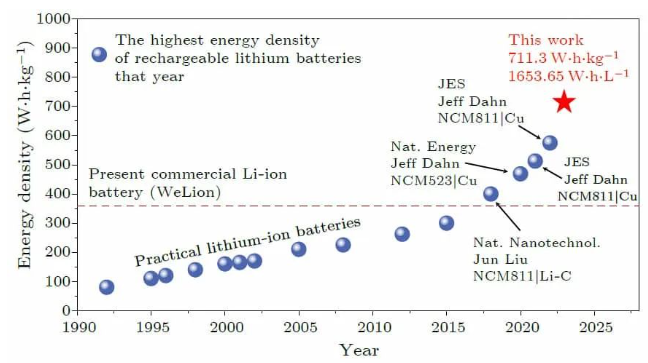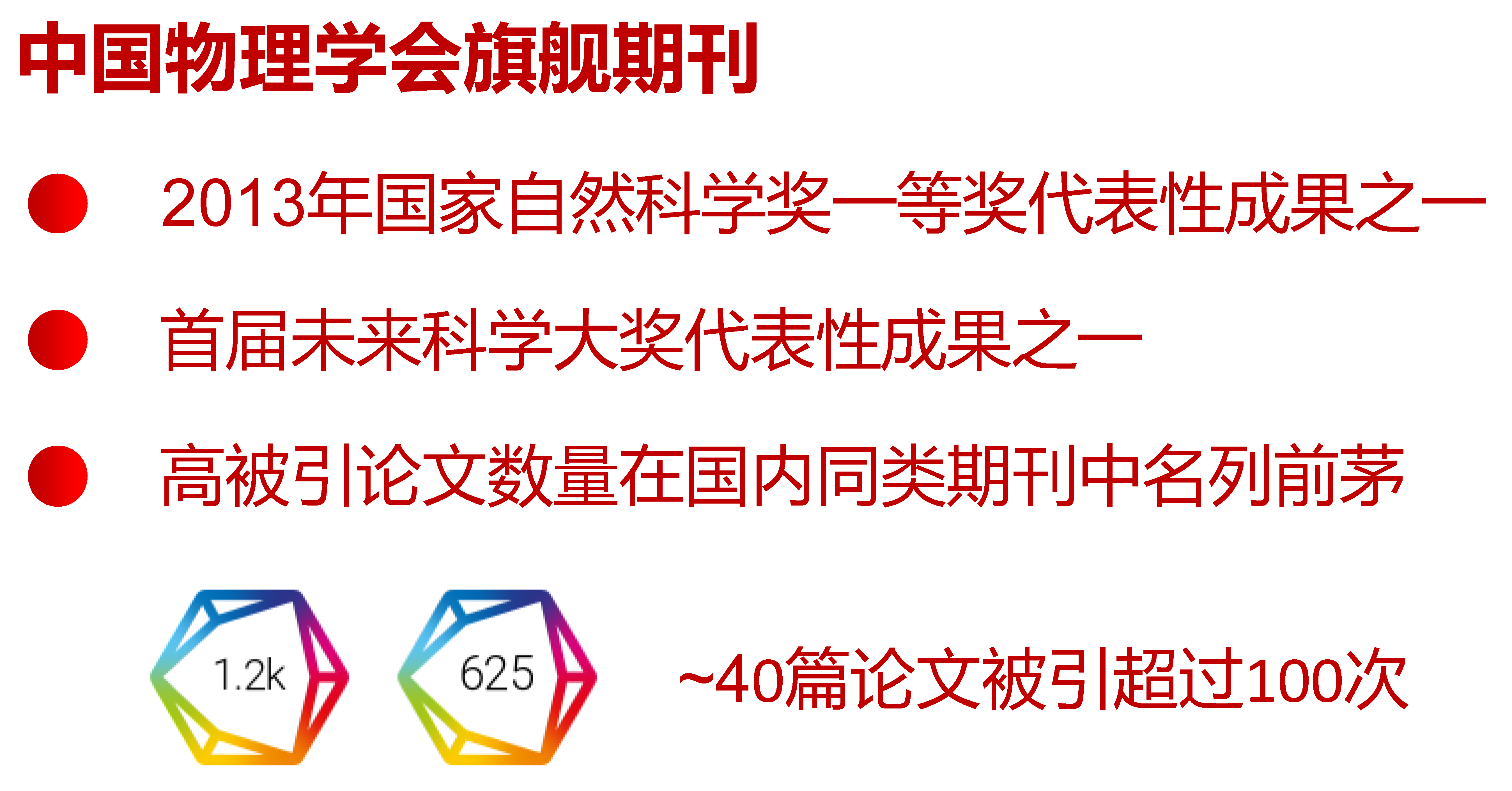博文
《物理世界》研究进展: 锂离子电池突破能量记录
|

EXPRESS LETTER
A 700 W⋅h⋅kg−1 Rechargeable Pouch Type Lithium Battery
Quan Li (李泉), Yang Yang (杨旸), Xiqian Yu (禹习谦), and Hong Li (李泓)
Chin. Phys. Lett. 2023 40 (4): 048201
DOI: 10.1088/0256-307X/40/4/048201
研究快讯
700 Wh/kg锂二次软包电池
研制了兼具超高质量能量密度和体积能量密度的10 Ah级软包锂二次电池,首次放电质量能量密度达到711.30 Wh/kg、体积能量密度达到1653.65 Wh/L。该数据在目前已公开报道的锂二次电池中能量密度居于世界前列。
Isabelle Dumé in Physics World wrote a research update that highlights this work.
https://physicsworld.com/a/lithium-ion-batteries-break-energy-density-record/
Lithium-ion batteries break energy density record

Technology advances: the energy density of lithium-ion batteries has increased from 80 Wh/kg to around 300 Wh/kg since the beginning of the 1990s. (Courtesy: B Wang)
Researchers have succeeded in making rechargeable pouch-type lithium batteries with a record-breaking energy density of over 700 Wh/kg. The new design comprises a high-capacity lithium-rich manganese-based cathode and a thin lithium metal anode with high specific energy. If developed further, the device could find use in applications such as electric aviation, which requires much higher energy density batteries than those available today.
Lithium-ion batteries are a key technology for helping to reach climate neutrality goals. They are increasingly being used to power electric vehicles and as the principal components of domestic devices that store energy generated from renewable sources. The technology has greatly advanced too: since first commercialized by Sony in 1991, the energy density of lithium-ion batteries has increased from 80 Wh/kg to around 300 Wh/kg.
Achieving a truly carbon-free economy, however, will require better-performing batteries than current lithium-ion technology can deliver. In electric vehicles, for example, a key consideration is for batteries to be as small and lightweight as possible. Achieving that goal calls for energy densities that are higher than 400 Wh/kg. The problem is that today’s lithium-ion batteries mainly contain intercalation-type cathodes (for example, LiFePO4, LiCoO2 or LiNixMnyCozO2, x+y+z=1) and graphite-based anodes, and the energy density of these electrodes is approaching its upper limit.
High charge-discharge voltage
In the new work, the researchers led by Xiqian Yu and Hong Li of the Institute of Physics, Chinese Academy of Sciences in Beijing, have manufactured practical pouch-type rechargeable lithium batteries by using an ultrathick high-discharge capacity Li1.2Ni0.13Co0.13Mn0.54O2 cathode with an areal capacity exceeding 10 mAh/cm2 and a lithium metal anode. The high charge-discharge voltage of the lithium-rich manganese-based oxides allows for a higher lithium-ion storage capacity.
“The anode electrode employs ultrathin metal lithium incorporated using a separator coating technique, which addresses the annoying issue of reversible deposition of ultrathin lithium of large surface capacity,” explains first author Quan Li.
The devices boast a gravimetric energy density of 711.3 Wh/kg and a volumetric energy density of 1653.65 Wh/L, both of which are the highest in rechargeable lithium batteries based on an intercalation-type cathode, Li tells Physics World.
“With respect to the battery manufacture, our extremity battery structure design (including the use of ultrathin current collectors) was tailored to minimize the usage of auxiliary materials while enhancing the proportion of active materials in the entire battery,” he adds. “This synergistic approach is what enabled the ultrahigh energy density of the batteries.”
Long-range electric vehicles and electric aviation could benefit
The new devices could benefit long-range electric vehicles and electric aviation, both of which place increasingly high demands on battery energy density. The research could also help address some of the inherent issues associated with battery technology, says Li.
“For instance, it offers insights into how to balance safety and other important factors in high-energy density batteries, which will help in the practical realization of high-energy density batteries in the future. Research on batteries with energy densities approaching theoretical limits will also help improve our knowledge of solid-state ionics and solid-state electrochemistry, allowing perhaps for technological innovation in new materials and battery systems.”
The researchers, who report their work in Chinese Physics Letters, explain that a trade-off always exists between the energy density, cycle performance, rate capability and safety of lithium-ion batteries. Safety is a primary requirement, but elevated energy density will increase the risks during battery operation, they say. “Energy density must be gradually improved while ensuring safety,” says Li. “Our goal is to enhance battery safety performance through solid-state battery technology, making high-energy density batteries more practical.”
The cycle performance of high-energy density batteries also still lags behind that of currently commercialized batteries, he adds. “This parameter needs to be comprehensively considered to meet the requirements of specific fields. It will therefore take considerable time for ultrahigh-energy density batteries to be practically applied. Addressing the challenges that hinder their practical usage will be the ongoing direction of our future research endeavours.”
© Copyright 2023 IOP Publishing Ltd
研究快讯集锦
利用解纠缠张量强化密度矩阵重整化群算法
基于第一性原理计算的Lu-H-N相图
基于范德华A型反铁磁CrSBr的自旋过滤隧道结中的巨大隧穿磁电阻
双层1T-TiSe2中的电子-激子耦合
Fe基Kagome晶格化合物单晶Y0.5Fe3Sn3的结构确定、非稳反铁磁态及输运行为
π介子质量分布的实验确定
700 Wh/kg锂二次软包电池
转角四层二硫化钼莫尔超晶格中铁电序与关联态的耦合
LuH2压力诱导的颜色变化
门电压可调的细直径InAs-Al纳米线超导量子比特
手性磁畴壁调控量子反常霍尔效应
“12442”型铁基超导体RbCa2Fe4As4F2中奇异的第二峰效应
利用时间合成维度构建光学神经网络
基于随机态含时演化的大尺度密度泛函理论计算方法
插层铁基(Li,Fe)OHFeSe:准二维高Tc超导电性
强场电离诱导的电子-空穴相干性实时测量
含记忆临界现象理论
光学克尔非线性谐振腔中的动态非互易
范德华铁磁/半导体异质结中的大室温磁电阻
准二维铁硒基超导体中普适赝能隙行为的核磁共振实验证据
兆巴高压下的金刚石NV中心光探磁共振
在超导量子电路中演示非阿贝尔系统的量子几何张量测量
基于里德堡原子基态封锁的双量子比特几何门
SrTiO3单晶立方相到四方相转变引起的弹性异常
氮化二聚钴:一类潜在的新型高温超导材料
Manakov方程中调制不稳定性和非简并Akhmediev呼吸子
表面粗糙的聚集和反聚集效应对电子隧穿的巨大影响
对数量子时间晶体
本征微观态的重整化群理论
伊辛模型的几何上临界维度
通过氢化钙退火方法连续掺杂Bi2212至电子掺杂超导体
氦离子注入制备的钇钡铜氧高温超导约瑟夫森结
变分角转移矩阵重正化群方法及其在经典统计模型中的应用
在单比特上基于量子态判别的互文性实验验证
巨行星内部可能存在的氦-二氧化硅化合物
范德瓦尔斯超导材料中准二维超导电性和可调控近藤晶格的共存
QCD强耦合常数在微扰及非微扰能区跑动行为的新分析
始于生成网络的马尔可夫链蒙卡
压力诱导具有超高能量密度的含氖聚合氮化物
FeSe超导体的反常能带劈裂和强各向异性超导能隙随掺硫的奇异演变
锁相热扩散趋肤效应
用于拓扑量子器件的纯相超细InAs–Al纳米线原位分子束外延
α-CsPbI3的缺陷容忍性:高温相材料中点缺陷性质的计算方法
Valence Quark Ratio in the Proton
高混合熵提升非晶合金的能量状态
在可调耦合超导量子比特中实现全微波脉冲的CZ门
BaO/SrTiO3界面的电输运性质研究
高通量第一性原理计算探索潜在的笼目材料

点此浏览所有Express Letters
CPL Express Letters栏目简介
为了保证重要研究成果的首发权和显示度,CPL于2012年6月开设了Express Letters栏目。此栏目发表速度快,学术质量高。截至2020年底,平均每篇被引用约20次,已经在国内物理学界建立起良好口碑与声望,来稿数量不断增加。

收录于合集 #Updates in Physics World 2上一篇阅读原文
https://blog.sciencenet.cn/blog-3426263-1389857.html
上一篇:《物理世界》研究进展: 激光干涉测量靠近散粒噪声极限
下一篇:研究快讯 | 钽基富氢化物高压合成和高压超导的发现